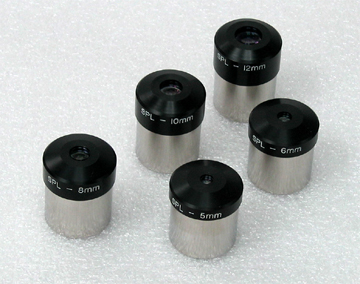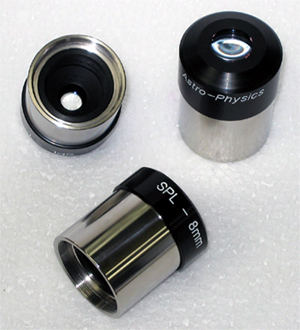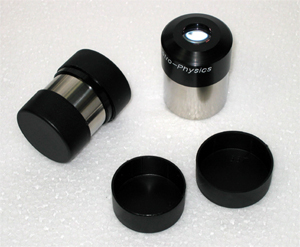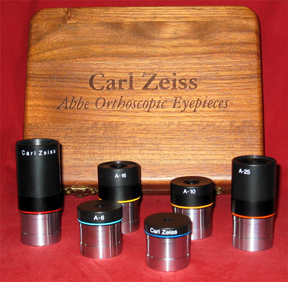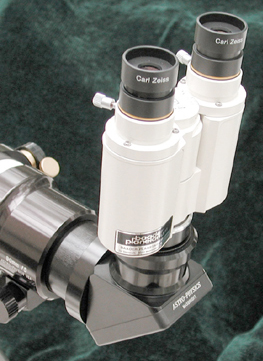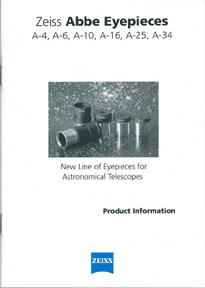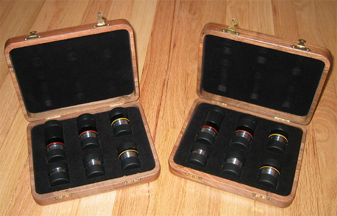https://www.cloudynights.com/topic/539425-docter-and-delos/page-3#entry7353054
1. Chromatic Aberration. This is essentially two different aberrations, but with similar effects, so I include them together, here. Eyepieces are made with lenses, and as such do not focus all colors at exactly the same point or with the same resolution. It is a very poor eyepiece that displays “blur circles” of different sizes for different colors on axis, but it is not at all uncommon for even excellent eyepieces to do so at the edge of the field. Center-of-field chromatic aberration is usually caused by having too few elements to correct for light’s tendency to have different wavelengths refract differently when passing through glass. Sometimes, lateral chromatic aberration is chosen as the “lesser of two evils” when correcting a nasty edge-of-field aberration that may be worse. Chromatic aberration can express itself as a color fringe to a bright object like a star or the edge of the Moon (chromatic aberration of the first type), or it can express itself as a slight prismatic effect seen when viewing sideways through the eyepiece, usually on the edge-of-field objects (chromatic aberration of the second, or lateral, type). This latter issue is often described as “lateral color”, but is a form of chromatic aberration that has its source in lateral distortion that changes with frequency. Also, if an eyepiece design is created to correct for color up to a lateral field size of, say, 50 degrees, but is created with a 60 degree field, that final 10 degrees of field may display color beyond the parameters of the designer, sometimes unpredictably. Daytime use will often show the extent of the problem easier than any nighttime viewing (except, perhaps, on the Moon). Some early eyepiece designs, such as Ramsden, Huyghens, or Kellner, do not correct well for either type of chromatic aberration, and should be avoided.
2. Field Curvature. Most telescopes’ final focal plane is curved—that is, the focal plane is convex or concave toward you and slightly curves as the field of view widens. Fortunately, this curvature is very slight in the narrow fields we observe through the telescope. Nonetheless, it is there. Eyepieces can have either negative (concave toward you) or positive field curvature depending on their designs, and this brings into play the idea of a telescope-eyepiece interaction that points out that eyepieces will perform differently in different scopes. If the negative curvature of the eyepiece matches the positive curvature of the telescope exactly, this can result in a perfectly flat field of view through the eyepiece through cancellation. Neither the eyepiece nor the telescope is perfect—merely the interaction between the two. This is why evaluating field curvature in an eyepiece is merely a statement of how the curvature appears in your scope. There may be other telescopes in which the eyepiece does not present the same field curvature (though the differences will be slight). Field curvature is seen as a defocusing of the star images at/near the edge of field. If further infocusing (racking the focuser toward the objective) focuses the stars at the edge, then the field curvature is positive. If outfocusing is necessary, then the curvature is negative. Young people, whose eyes can accommodate more focal differences than older people, will be bothered less by this aberration. Ideally, if an eyepiece has no field curvature, all that will display is the very slight curvature from the scope itself, which is highly unlikely to be visible. Note that this is NOT the same aberration that causes a feeling of “looking through a fishbowl” when panning the scope.
3. Angular magnification distortion. This is where the magnification factor at the edge of the field is not the same as it is in the center. I see this all the time in well corrected binoculars, and it is there as a side-effect of correction for rectilinear distortion in wider fields of view(I’ll discuss this next). In an astronomical usage, this is not usually a severe aberration (unless a very high percentage), but it does play havoc with trying to figure out what the apparent field or true field of an eyepiece is. The speed with which an object will drift across the FOV in an undriven scope would not be linear, but change with distance from center. This can result in a star-drift timing (to determine the true field of view) that results in a true field that cannot be derived from the apparent field quoted for the eyepiece. As an extreme case, picture sitting in space and watching a city on the Earth as it first appears on the limb, then traverses the disc and finally exits the view. It will move fastest when moving across the center, yet slowly when entering and exiting the FOV. A timing of the passage would lead you to calculate a wider field for the image of the Earth than actual. As a comparison, this would mean, in an eyepiece, that the true field of view is wider than the apparent field would calculate. And the reverse can be true as well. Fortunately for us, this distortion is usually small in eyepieces (though ultrawidefields could and would have more of this unless specifically corrected). Most star drift timings of true field result in only small discrepancies from the apparent field predictions of true field. In a telescope, a completely uncorrected angular magnification distortion will result in different spacings of details in objects as they approach the edge of the field.
4. Rectilinear distortion. This is the distortion at the edge of the field that causes straight lines to bow in toward the center (called pincushion distortion) or bow out away from the center (called barrel distortion). It is usually unnoticeable in star fields, and is often tolerated. The eye, for instance, sees a small percentage of pincushion distortion as being distortionless. It does mean that the geometric arrangement of the stars in a field of view will be different at the edge of the field than in the center, but this is easily tolerated. This is a horrible aberration for an eyepiece in binoculars, when used on land objects in the daytime, but is no big deal in an astronomical setting. However, people who pan their scopes back and forth often get nauseated by the change in shape this can cause in the field of view. If your usage involves a lot of scanning of the skies, this may be an aberration you won’t want to tolerate (though angular magnification distortion isn't any better--as they say, distortion is distortion). For most of us, though, it is so hard to see that it is quite preferable to astigmatism, the aberration it can help hold in check. In ultrawide fields of view, this aberration is present when angular magnification distortion is corrected. If corrected, angular magnification distortion will be present. These two aberrations cannot be simultaneously corrected in widefield eyepieces. Lucky for us, the eye will see distortion at the edge of a field unless there is some rectilinear distortion present, so eyepieces specifically designed for astronomy often leave this aberration in place and correct angular magnification distortion instead.
5. Astigmatism. This is caused by the vertical (sagittal) curvature of the eyepiece field being different that the horizontal (tangential, or meridional) curvature of the eyepiece field. This, in daylight use, causes a defocusing/blurring of the edge of the field of view. At night, it causes the stars at the edge of the field to appear as short radial lines on one side of focus, and short circumferential lines on the other. In focus, the star images may appear slightly blurry or cross-shaped (center) or appear like seagulls or bats (at the edge, when combined with other aberrations). This is the most prevalent problem with inexpensive widefield eyepieces, and is worse when the focal ratio of the telescope is short (say, f/3-f/5). Astigmatism can also be caused by tilted elements in the eyepiece housing, or wedge (faces of lenses not in same axial lineup), or miscollimation of the optical axis with the axis of the focuser. It can also be caused by an interaction of the eyepiece design with the astigmatism of the telescope’s objective or the improper tilt of a mirror, which is why we are looking for an aberration that is equal in all directions from center in the FOV, where the eyepiece is concerned.
6. Spherical aberration. With multiple elements, this would seem to be tightly controlled in eyepieces, yet it can be an issue. This would manifest itself as different parts of the axial ray (or all rays, for that matter) coming to focus at different places. The result is a blurred image (one that doesn’t focus well or seems to have a long range of best focus) that cannot be sharply focused. I will state that the amount of this present in eyepieces is so small compared to the objectives that, to all intents and purposes, it is not there. What tiny amounts are present would largely go unnoticed.
7. Spherical Aberration of the Exit Pupil (SAEP). This is found in some eyepieces and is described as having different parts of the eyepiece’s eye relief dimension be different depending on the point in the field of view. How you would see it is that at different distances away from the eyepiece, you would see the outer edges of the field, or the center, or one edge or the other, but not at the same time. The field of view would appear to have kidney bean-shaped dark areas drifting around the field, depending on where you were holding your eye. There would be only one position for the eye that would result in most of the field of view being visible and in focus at the same time, and you might have to rock your head from side to side to see the edges of the field, one after the other. In essence, the exit pupil of the eyepiece, instead of being a small, circular plane, is a curved surface, usually curving away from the eye in all directions from center. The original Nagler Type 1 eyepieces, especially the 13mm, displayed this aberration, and the correction for it was the genesis of the Nagler Type 2. Most of the other eyepieces exhibiting this characteristic are long focal length eyepieces, or eyepieces with long eye reliefs, though it should be noted that blackout problems with an eyepiece do not necessarily indicate spherical aberration of the exit pupil. It can also indicate the viewer is holding his eye too close to the eyepiece.
8. Transmission anomalies by wavelength. This is exemplified by an eyepiece’s not transmitting all wavelengths of light with equal intensity. At best, it means a light rolling off of transmission at the extremes of the visual spectrum. At worst, it means a noticeable tint in the field of view, especially on the Moon. This is possible in most eyepieces. The difference is only in severity or noticeability.
9. Vignetting. This is a loss of edge brightness (transmission anomaly by distance from center) due to improper lens diameters (one element unable to field the entire set of rays from the preceding one), barrel diameter (too small an internal diameter to pass all edge-of-field rays), or simply normal design (a 40mm eyepiece in a 1-1/4” barrel will vignette rays at the edge so that, regardless of lens diameter, the field of view will be truncated by the barrel’s entrance diameter). The causes of vignetting, where it is described as being due to the size of the secondary mirror or telescope opening aperture, is really a sub-optimal relationship of the field of the eyepiece and the telescope’s focal plane. It is not the eyepiece that is vignetting, in that case, but the use of too large an eyepiece for the telescope’s illuminated field. Vignetting in an eyepiece is harder to see, and can often be seen only by holding the eyepiece up to a bright sky and looking at the edges of the field. If it noticeably darkens at the edge, there is vignetting involved. If it doesn’t noticeably vignette, it could still be there in lab tests, but is unlikely to cause problems in viewing.
10. Coma. Yes, eyepieces can have coma. It is the same as coma in a short focal length lens or mirror, but is significantly smaller in quantity. It expresses itself, usually, as a radial unsharpness in the star images, as they move from center to edge, that gets gradually worse toward the edge. Because astigmatism is likely to be more severe and more noticeable, I am not sure how you would tell the eyepiece has coma other than by ray-tracing the design. It might be possible to notice it in a completely flat-field telescope that lacks coma (f/30 refractor?), but in the real world, coma is 99.99% an issue with the primary objective. Very simple designs can exhibit coma, but you are staying away from these, aren’t you?
11. Light loss. This can be caused by back reflection from lens surfaces, absorption by the lens elements (lack of transparency or tint), scatter from the lens surfaces causing destructive interference in the wavefront, and internal vignetting. I talk about each of these issues separately, but I lump them together as light loss. Ultimately, the reach of your telescope is dependent on the maximum transmission of each element. The eyepiece is merely a link in the chain.
12. Wavefront aberrations. This is similar to the problems caused by an inaccurate mirror surface, except that an eyepiece has many such surfaces. The reduction in the quality of the final image can come from poor polish on the lens surfaces (+/- wavelength %), poor figure (the lack of correspondence of the surface curves to design parameters—like the Hubble, originally), or an increase in the number of surfaces. This is where fewer elements can be better. Unless the surfaces are all perfect (and that is HIGHLY unlikely), the more surfaces there are the more likely the final image’s quality is likely to be reduced by these aberrations. Unfortunately, one manufacturer’s 8-element eyepiece may have a final wavefront that is more accurate than another manufacturer’s 3-element eyepiece, so we are truly generalizing when we say fewer elements are better. In specific, this may not be true.
13. Loss of contrast due to light scatter. This is not, technically, an aberration, yet it is a problem in eyepieces that causes a diminution of the final image quality. It is caused by light scatter due to poorly polished optical surfaces, lens reflections due to edge-of-lens reflection, lens reflections due to poorly applied or absence of coatings, low angle-of-incidence scattering from the lens coatings, and shiny internal surfaces in the barrels and baffles. It is exemplified by a “graying out” of the background sky in a given eyepiece. Since larger apertures and/or lower powers show lighter background skies, the only way to really tell about the presence of this one is to compare another eyepiece of exactly the same field of view and focal length, or to put a bright object just outside the field of view and see if you can detect any internal evidence of the direction in which the bright object lies. Ideally, if a bright object leaves the field, there should be no visible evidence of its direction left in the field. Likewise, there should be no halo around any object, no matter how bright, that changes the darkness of the background sky around the object. In practice, many such problems are caused by the eye, or dirt or dew on the optics, or haze in the sky, so steps should be taken to minimize those issues before any form of evaluation. Ideally, this is one that should be measured on a test lab’s bench, but we don’t have access to such data as of yet. It needs to be noted that a bright object in a reflector telescope may have bright spikes emanating from the star or object, and these spikes may be visible until the object leaves the field of view of the telescope, which will be larger than the field of view of the eyepiece. This is not the form of light scatter to which I refer.
14. Thermal issues. If an inadequate clearance is left between the housing and the internal lens elements, as the barrel shrinks it may squeeze and/or bend the internal elements. This is more likely to be a problem in larger eyepieces, where the temperature differential between the housing and the internal elements is likely to be the highest. Big eyepieces like the 31mm Nagler have to come to thermal equilibrium, just like telescope objectives, in order to give their best images. Fortunately, the eyepiece will be at equilibrium before the mirror. This is a valid reason to NOT carry the eyepieces in a coat pocket or to store them in a closed case until used. In places where dew is a problem, the eyepiece may have to be maintained at a warmer temperature. That isn't optimum, but it's preferable to fogging or even frosting of the eyepiece.
15. Design flaws in the eyepiece. I’ve lumped these together, even though it is several issues. They are indicative of qualitative issues with the eyepiece design, and can indicate why you may not want to buy any of said eyepieces. Examples:
---- Field stop not in focus (improperly placed field stop results in vague field edge).
---- Wrong refractive index of glass used, resulting in aberrations not in the original design—this can be true of later versions of an earlier design.
---- Critical f/ratio too high—wherein the eyepiece manufacturer designed the eyepiece to adequately field the narrow light cone of an f/15 refractor (for example), but not an f/4.5 reflector. Personally, I think all eyepieces should be designed to handle the wider f/4 light cone well. Why should we have to become aware of which eyepiece does or does not work in our f/4.5 reflectors? This is a problem with many companies, unfortunately.
---- Improper internal design, leading to vignetting or internal reflections. These are issues easily addressed, yet so many eyepieces do not. It may mean a poor optical design, a poor manufacturer, or too tight a budget to produce a good eyepiece. Whatever the reason, this is a good reason to eschew the purchase and use of these eyepieces until the problems are solved.
I’ve been very liberal in my use of the word aberration to include any deviation from a perfect image at the exit pupil of the eyepiece. It must be noted that these aberrations, though real, detract less, usually, from the final image quality than do the grosser aberrations of the primary mirrors and lenses. One should address, in designing the optimum optical system for one’s budget, the quality of the mirrors and eyepieces together, for, ultimately, it is the combination of these elements that produces the final image



